Putting the Art in Fractal Art
Chump Change (2006)
The way I saw my art changed when I started working with a master printer to make poster-sized Giclees of my own work. I began to see my images on the wall rather than on the screen.
My work habits shifted noticeably. I started creating in the largest sizes my poor computer could tolerate without coughing and crashing. Each new image became a canvas, and my eyes adjusted to looking at sections of a big picture work-in-progress rather than conventional monitor sizes.
And, suddenly, the details and nuances of texture became paramount.
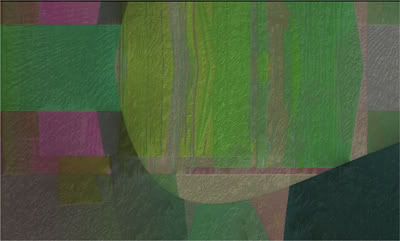
Upper left corner detail of Chump Change
Size became whatever I could muster. Memory became my enemy. My work computer has four gigs of RAM, and I can work at 8000 x 8000 pixels -- usually -- unless I want to post-process heavily.
And I do -- with extreme prejudice -- which cuts down my comfort zone closer to around 6000 x 6000 pixels. But I can thrash about in Photoshop or Painter with wild abandon and still layer/render away at a steady clip.
And why post-process? It's really not for the fractal. After all, it's already there (or, at least, what's left of it).
I post-process for the art.
Accusers (2006)
But I'm getting ahead of myself. Let's go back to the beginning.
I didn't get into fractals for the math. I took them up because -- finally -- I saw a way that I could make art.
I'd tried before. I took a beginning art class when I was college. It was a frustrating experience. I couldn't make my paintings look anything like what I saw in my head. The professor eventually suggested I drop the class -- while adding, for good measure and for the benefit of my long-term self-esteem, that I "probably had no talent."
I know what you're thinking. Don't say it.
But the prof was right in one sense. I couldn't deal with the conventional tools of art. The brush seemed pudgy and awkward. I always felt like I was stabbing the canvas with a cucumber. I never could gage how much or how little paint would produce the desired thickness. Everything dried too fast or dripped too much. And the smell of the chemicals gagged me and made my head feel like a cinder block.
I gave up -- and took up writing instead. The pen felt just fine in my hand, and I had an overdose of images already in my head.
Then, one day in 1997, I saw my first fractal on Usenet.
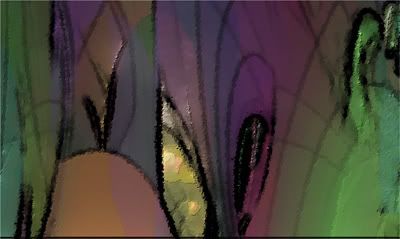
And I've been playing with fractals ever since. At first, I just churned 'em out like an assembly line. I was fascinated by how minor adjustments produced subtle changes with each subsequent iteration. Sometimes, I felt more like a machine than the computer itself.
But I slowed down considerably once I began to post-process. I started to labor over images and refused to be satisfied until each was either finished (abandoned?) as the closest approximation of my head shot -- or every layer was sent kicking to the Recycle Bin.
And that's when I realized I'd found a way to begin painting. Fractals became my base canvas. I wasn't afraid, to the consternation of some, to mess everything up. The fractal forms weren't sacrosanct to me. Only the final result mattered.
I believe making art is like a knife fight. There are no rules. You either survive the ordeal with something from nothing to show for it. Or your vision dies.
Sorceress (2006)
So, now, I was "painting" regularly, composing more carefully, and doting over textures -- at least, those I could see working within a scale of 800 x 600 pixels. Still, I found myself wondering: Am I making art?
And how would I ever know unless I could really see what I was doing?
But, as I said, everything changed after I met with a professional printer and saw my first poster-sized Giclee. I had new improved eyes -- and with fresh sight came further adjustments in my process. I worked even more slowly. I realized my early images were like a cup of black coffee. The latter ones became like a tongue-twisting, labor-intensive specialty coffee from Starbucks.
Thinking big is like making the jump to high-definition television. Textures matter. Every pixel shows. And once that mindset took hold, I finally felt like I was thinking like an artist.
I'm glad I worked with a professional printer -- an artist himself -- because he had the experience and the equipment to make a museum-quality product. Acid free inks and papers make a difference. And although photographic prints are lush and can scale up quite large, I was drawn to the gentler (as in less saturated), smaller Giclees. Surfaces in Giclee are remarkably tactile -- with brush strokes evident and raised and indented areas becoming peaks and valleys. And the first time I saw an image printed on canvas and covered with a chemical wash, I knew...
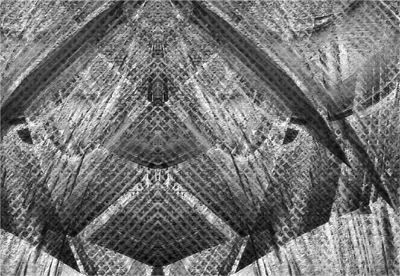
...I knew I was looking at a painting.
A program like Fractal ViZion (which I like, by the way) can produce endless fractals with one mouse click. It doesn't need us to produce fractals. Besides, nature's already doing a fine job of churning them out -- thank you very much.
And, although I don't use Ultra Fractal, I think I understand (at least in part) why so many fractalists are drawn to it. The software can produce striking, intricate textures. I know that's why I was excited to help beta-test XenoDream. It wasn't for the 3D forms. It was for the incredibly lush and complex textures.
I'm not advocating my way or the highway, you understand. I'm just encapsulating my journey to finding art in fractals.
I do believe fractals can be more than what math wrought.
And much more than decoration.
They can be fine art -- and all that goes with it.
So don't be afraid to paint -- whether in-house with UF or XenoDream or outsourced to Photoshop et. al. And don't shy away from seeing the small screen as the big picture on your wall.
Yes, we have the tools. But we also need to cultivate the vision -- along with the talent and patience to bring it into existence.
We put the art in fractal art.

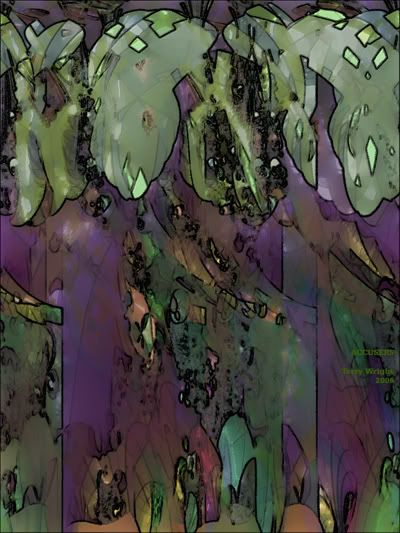
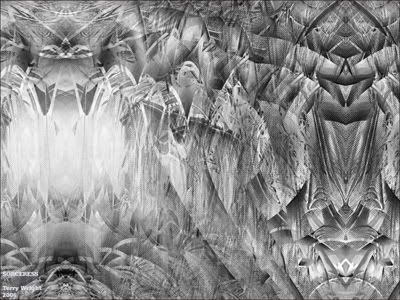




3 Comments:
I didn't get into fractals for the math. I took them up because -- finally -- I saw a way that I could make art.
I'd tried before. I took a beginning art class when I was college. It was a frustrating experience. I couldn't make my paintings look anything like what I saw in my head.
I was better at copying other works for practice in class than creating my own. I'm not really a visual person. When I read a book I don't get a picture of the characters or setting. So I don't actually have "images in my head" to recreate (and I guess this also relates to my liking abstracts so much), but it turns out that I can develop one when I see an interesting starting point. Thus fractals and photography are a way for me to be creative.
12/19/2006 5:43 PM
Fractals and photography. That's all I've ever used. And the photography has been old public domain works I've gotten off the internet and worked on in my graphics program. It's all about being creative in the most productive way you can or in the way which catches your interest. Maybe we would all have worked harder at the traditional methods if it weren't for these more exciting options that we've discovered.
The electric guitar; isn't that post-processed guitar music? If anyone called that second-rate nowadays they'd be laughed at. Or photography. No one questions the artistic value of photographs anymore. Eventually people will become more familiar and sophisticated with regards to the digital medium and see it for what it is: just another way of making art.
12/19/2006 11:15 PM
@Terry, I'd say you got the last laugh on your old art prof! :-)
@Tim, electric guitar music could be considered post-processed, with all the gizmos that can be patched in between the instrument and the amp. And virtually all music on CD, even if recorded live at shows, is "massaged" in the studio - sometimes to boost parts that were too quiet or dampen parts too loud, sometimes to have wildly enthusiastic crowd cheering overdubbed onto it when the audience was in fact rather blase. As a singer from an obscure band put it, "nobody sounds like they do on the record!".
12/23/2006 1:12 PM
Post a Comment
<< Home